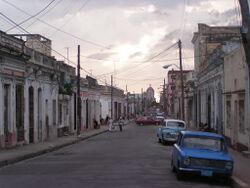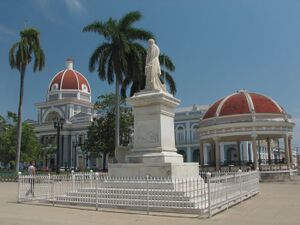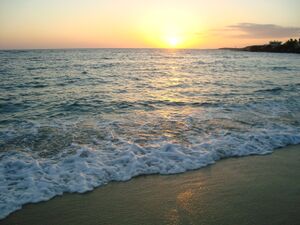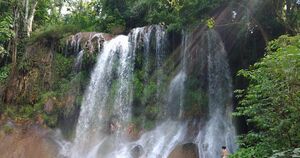سيينفويغوس
سيينفويگوس
Cienfuegos | |
|---|---|
 Typical street in Cienfuegos | |
| الكنية: La Perla del Sur (Pearl of the South) | |
 Cienfuegos municipality (red) within Cienfuegos Province (yellow) and Cuba | |
| الإحداثيات: 22°08′44″N 80°26′11″W / 22.14556°N 80.43639°W | |
| البلد | كوبا |
| المقاطعة | سيينفويگوس |
| Founded | 1819[1] |
| المساحة | |
| • الإجمالي | 333 كم² (129 ميل²) |
| المنسوب | 25 m (82 ft) |
| التعداد (2012)[3] | |
| • الإجمالي | 164٬924 |
| • الكثافة | 500/km2 (1٬300/sq mi) |
| صفة المواطن | Cienfuegueros |
| منطقة التوقيت | UTC-5 (EST) |
| Postal code | 55100-55500 |
| مفتاح الهاتف | +53 43 |
| لوحة السيارة | CF |
| الاسم الرسمي | Urban Historic Centre of Cienfuegos |
| النوع | Cultural |
| المعيار | ii, v |
| التوصيف | 2005 (29th session)[4] |
| الرقم المرجعي | 1202 |
| State Party | Cuba |
| Region | Latin America and the Caribbean |
سيينفويگوس أو سيينفويغوس (Cienfuegos ؛ النطق الإسپاني: [sjeɱˈfweɣos])، هي عاصمة مقاطعة سيينفويگوس، وهي مدينة على الساحل الجنوبي لكوبا.[5] It is located about 250 km (160 mi) from Havana and has a population of 150,000. Since the late 1960s, Cienfuegos has become one of Cuba's main industrial centers, especially in the energy and sugar sectors.[6] The city is dubbed La Perla del Sur (Pearl of the South). Although Cienfuegos literally translates to "one hundred fires" (cien, "one hundred"; fuegos, "fires"), the city takes its name from the surname of José Cienfuegos, Captain General of Cuba (1816–19).
In 2005, UNESCO inscribed the Urban Historic Centre of Cienfuegos on the World Heritage List, citing Cienfuegos as the best extant example of early 19th century Spanish Enlightenment implementation in urban planning.[7] The downtown area contains six buildings from 1819–50, 327 buildings from 1851–1900, and 1188 buildings from the 20th century. There is no other place in the Caribbean which contains such a remarkable cluster of Neoclassical structures.
التاريخ
The area where the city lies was identified as Cacicazgo de Jagua by early Spanish conquistadors. It was originally settled by Taino indigenous people. Cacicazgo translates from the Taino language as "chiefdom". Cacicazgo de Jagua was therefore the chiefdom of Chief Jagua.
The city was later settled by French immigrants from Bordeaux and Louisiana led by Don Louis de Clouet on April 22, 1819.[1] The settlers named the city Fernandina de Jagua in honor of King Ferdinand VII of Spain and Chief Jagua.[8] The settlement successively became a town (villa) in 1829, renamed for José Cienfuegos, Captain General of Cuba (1816–19), and a city in 1880. Many of the streets in old town reflect French origins in their names: Bouyón, D'Clouet, Hourruitiner, Gacel, and Griffo, for instance.
Cienfuegos port, despite being one of the latest settlements established during the colonial era, soon grew to be a powerful town due to the fertile fields surrounding it and its position on the trade route between Jamaica and South American cities to the southeast and the hinterland provincial capital of Santa Clara to the northeast. Its advantageous trading location on the historically eponymous Bay of Jagua was used by the Cuban sugar oligarchy when a railroad was built between both cities between 1853 and 1860.[9][10]
Near Cienfuegos was the scene of a battle during the Spanish–American War on May 11, 1898, between American Marines attempting to sever underwater Spanish communication lines and the Spanish defenders.
During the Cuban Revolution, the city saw an uprising against Fulgencio Batista and was bombed in retaliation on September 5, 1957.[11] The city later became a key industrial center, part of the revolutionary government's "anti-urban" planning policy, with industrial projects including the never-completed Juraguá nuclear power plant, the "Camilo Cienfuegos" oil refinery, and the "Carlos Marx" cement factory.[12]
In 1969 and 1970, Soviet naval vessels visited the city. This appeared to be in violation of the Kennedy–Khrushchev agreements of 1962. However, there was no notice given by the United States, and no confrontation ensued.[13]
In 2005, Hurricane Dennis made its second landfall near Cienfuegos at about 1:00PM AST (17:00 UTC) with winds of 232 km/h (144 mph) and gusts reaching 285 km/h (177 mph).
الجغرافيا
Near the entrance to Cienfuegos Bay is Castillo de Jagua (full name: Castillo de Nuestra Señora de los Angeles de Jagua), a fortress erected in 1745 for protection against Caribbean pirates.
Cienfuegos, one of the chief seaports of Cuba, is a center of the sugar trade as well as coffee and tobacco. While sugarcane is the chief crop, local farmers also grow coffee.
المناخ
According to the Köppen Climate Classification system, Cienfuegos has a tropical savanna climate, abbreviated "Aw" on climate maps.
| بيانات المناخ لـ سيينفويگوس | |||||||||||||
|---|---|---|---|---|---|---|---|---|---|---|---|---|---|
| الشهر | ينا | فب | مار | أبر | ماي | يون | يول | أغس | سبت | أكت | نوف | ديس | السنة |
| القصوى القياسية °س (°ف) | 31.1 (88.0) |
32.8 (91.0) |
33.3 (91.9) |
32.8 (91.0) |
34.4 (93.9) |
35.0 (95.0) |
35.0 (95.0) |
34.4 (93.9) |
35.0 (95.0) |
33.9 (93.0) |
32.8 (91.0) |
31.7 (89.1) |
35.0 (95.0) |
| متوسط القصوى اليومية °س (°ف) | 27.2 (81.0) |
27.8 (82.0) |
28.9 (84.0) |
29.4 (84.9) |
30.6 (87.1) |
31.7 (89.1) |
32.2 (90.0) |
32.2 (90.0) |
31.7 (89.1) |
31.1 (88.0) |
28.3 (82.9) |
27.8 (82.0) |
29.9 (85.8) |
| المتوسط اليومي °س (°ف) | 22.2 (72.0) |
22.3 (72.1) |
23.4 (74.1) |
24.4 (75.9) |
25.6 (78.1) |
26.7 (80.1) |
27.2 (81.0) |
27.2 (81.0) |
26.7 (80.1) |
26.7 (80.1) |
23.9 (75.0) |
22.8 (73.0) |
24.9 (76.8) |
| متوسط الدنيا اليومية °س (°ف) | 17.2 (63.0) |
16.7 (62.1) |
17.8 (64.0) |
19.4 (66.9) |
20.6 (69.1) |
21.7 (71.1) |
22.2 (72.0) |
22.2 (72.0) |
21.7 (71.1) |
21.7 (71.1) |
19.4 (66.9) |
17.8 (64.0) |
19.9 (67.8) |
| الصغرى القياسية °س (°ف) | 7.8 (46.0) |
7.2 (45.0) |
7.2 (45.0) |
10.0 (50.0) |
13.3 (55.9) |
18.9 (66.0) |
20.0 (68.0) |
19.4 (66.9) |
20.0 (68.0) |
15.6 (60.1) |
11.1 (52.0) |
8.9 (48.0) |
7.2 (45.0) |
| متوسط تساقط الأمطار mm (inches) | 18 (0.7) |
25 (1.0) |
33 (1.3) |
46 (1.8) |
119 (4.7) |
152 (6.0) |
122 (4.8) |
160 (6.3) |
173 (6.8) |
160 (6.3) |
41 (1.6) |
23 (0.9) |
1٬072 (42.2) |
| Source: Sistema de Clasificación Bioclimática Mundial[14] | |||||||||||||
الديمغرافيا
In 2004, the municipality of Cienfuegos had a population of 163,824.[3] With a total area of 333 km2 (129 sq mi),[2] it has a population density of 492.0/km2 (1،274/sq mi).
الرياضة
Cienfuegos fields a team in the Cuban National Series, the Cienfuegos Elefantes. Since joining the league in 1977–78, the best finish the Camaroneros have achieved is a 3rd place showing in the 2010–11 Cuban National Series. Despite finishing with the best record at 59–31, the Elefantes lost the semifinals in six games to the eventual champions, the Pinar del Río Vegueros.
المعالم
- Castillo de Nuestra Señora de los Ángeles de Jagua – fortress
- Arco de Triunfo – the only Arco de Triunfo in Cuba
- Catedral de Nuestra Señora de la Purísima Concepción – cathedral with stained glass work, built 1833–1869
- Delfinario – dolphins and sea lions in a saltwater lagoon
- Jardín Botánico de Cienfuegos – 97 hectares of botanic garden
- Museo Provincial – furniture and porcelain museum
- Palacio de Valle – built 1913–1917 in neo-gothic style
- Palmira Yorubá Pantheon – museum of religious afro-catholic syncretism
- Parque José Martí – park in Plaza de Armas
- Teatro Tomás Terry – colonial style theater
- Palacio Ferrer
- Malecón de Cienfuegos
- Paseo del Prado – longest street in Cuba, full of colorful buildings
- Quintero (cigar) cigar factory
- University of Cienfuegos "Carlos Rafael Rodríguez" (UCF) – the province's high education institution
- Rancho Luna Beach
- Nicho
- Laguna del Cura - an authentic fishing boat lagoon.
أبرز الشخصيات
- José Abreu, MLB player for the Chicago White Sox
- María Conchita Alonso, Cuban-Venezuelan-American singer; born here
- Yordany Álvarez, MLS player for Real Salt Lake
- Joe Azcue, MLB player for the Cincinnati Reds, Kansas City Royals, Cleveland Indians, Boston Red Sox, California Angels, and Milwaukee Brewers
- Luis Posada Carriles, Cuban anti-Castro activist believed to be responsible for the Cubana Flight 455 bombing; born here
- Benny Moré, Cuban singer
- Gina Pellón, Cuban painter; lives in exile in Paris
- Maikel Pérez, Cuban wrestler and mixed martial artist; born here
- Yasiel Puig, MLB player for the Cleveland Indians; born here
- Osmel Sousa, Cuban-Venezuelan entrepreneur and former president of the Miss Venezuela Organization.
- José Tartabull, MLB player for the Boston Red Sox
- Cristóbal Torriente, Cuban-born Hall of Fame baseball player
المدن الشقيقة
Cienfuegos has the following sister cities:
 Tacoma, Washington, United States
Tacoma, Washington, United States Etzatlán, Mexico[15][16]
Etzatlán, Mexico[15][16] Cambridge, Massachusetts, United States
Cambridge, Massachusetts, United States Kingston, Ontario, Canada (2005)
Kingston, Ontario, Canada (2005) Bahía Blanca, Argentina
Bahía Blanca, Argentina Saint-Nazaire, France
Saint-Nazaire, France Contagem, Brazil
Contagem, Brazil
معرض صور
Cathedral of Cienfuegos and Medici Lions
The central Calle D'Clouet with the "Hotel La Unión" (left) and the railtrack remains of the former urban tramway
انظر أيضاً
الهامش
- ^ أ ب "Cienfuegos". Guije.com (in الإسبانية). Retrieved 2007-10-07.
- ^ أ ب Statoids (July 2003). "Municipios of Cuba". Retrieved 2007-10-07.
- ^ أ ب Atenas.cu (2004). "2004 Population trends, by Province and Municipality" (in الإسبانية). Archived from the original on 2007-09-27. Retrieved 2007-10-07.
- ^ "Decision: 29 COM 8B.53". Decisions of the 29th Session of the World Heritage Committee (PDF). Durban: UNESCO. 2005. p. 143.
- ^
 Chisholm, Hugh, ed. (1911). . دائرة المعارف البريطانية. Vol. 6 (eleventh ed.). Cambridge University Press. p. 364.
Chisholm, Hugh, ed. (1911). . دائرة المعارف البريطانية. Vol. 6 (eleventh ed.). Cambridge University Press. p. 364. {{cite encyclopedia}}: Cite has empty unknown parameter:|coauthors=(help) - ^ Cederlöf, Gustav (2020). "The Revolutionary City: Socialist Urbanisation and Nuclear Modernity in Cienfuegos, Cuba" (PDF). Journal of Latin American Studies. 52: 53–76. doi:10.1017/S0022216X19000920.
- ^ Centre, UNESCO World Heritage. "Urban Historic Centre of Cienfuegos". whc.unesco.org. Retrieved 7 April 2018.
- ^ Ojeda Cabrera, Mireya. "Cienfuegos a 190 años de fundada" (in الإسبانية). Radio Rebelde. Retrieved 23 September 2016.
- ^ Santa Clara railway station (Cuba)
- ^ Zanetti Lecuona, Oscar; García Alvarez, Alejandro (27 June 2002). Sugar & Railroads: A Cuban History, 1837–1959. Scholarly Book Services Inc. pp. 51–53. ISBN 978-0807846926.
- ^ "Castro speech commemorates Moncada assault". lanic.utexas.edu. University of Texas. Archived from the original on 2006-09-08.
- ^ Cederlöf, Gustav (2020). "The Revolutionary City: Socialist Urbanisation and Nuclear Modernity in Cienfuegos, Cuba" (PDF). Journal of Latin American Studies. 52: 53–76. doi:10.1017/S0022216X19000920.
- ^ R., Milton. "The Soviet Military Buildup in Cuba". The Heritage Foundation. Retrieved 7 April 2018.
- ^ "Cuba–Cienfuegos". Centro de Investigaciones Fitosociológicas. Retrieved June 14, 2015.
- ^ "Secretaría de Relaciones Exteriores - Gobierno - gob.mx". www.sre.gob.mx. Retrieved 7 April 2018.
- ^ http://www.sre.gob.mx/coordinacionpolitica/images/stories/documentos_gobiernos/rai/jal/jal40.pdf
ببليوگرافيا
وصلات خارجية
 Cienfuegos travel guide from Wikivoyage
Cienfuegos travel guide from Wikivoyage- Guide of Cienfuegos
- Photo collections with most of the city's landmarks on Flickr
- Pages using gadget WikiMiniAtlas
- CS1 الإسبانية-language sources (es)
- مقالات المعرفة المحتوية على معلومات من دائرة المعارف البريطانية طبعة 1911
- Short description is different from Wikidata
- Coordinates on Wikidata
- Articles with hatnote templates targeting a nonexistent page
- سيينفويگوس
- مدن كوبا
- أماكن مأهولة في مقاطعة سيينفويگوس
- Port cities and towns in Cuba
- مواقع التراث العالمي في كوبا
- أماكن مأهولة تأسست في 1819
- تأسيسات 1819 في اسبانيا الجديدة
- تأسيسات عقد 1810 في جزر الهند الغربية الاسبانية









